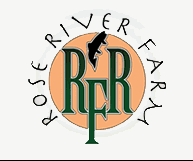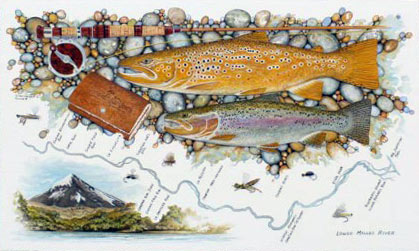Lake Trout, February 2013, Fish of the Month!
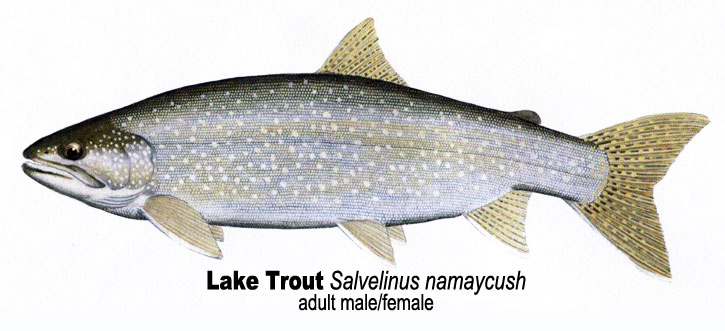
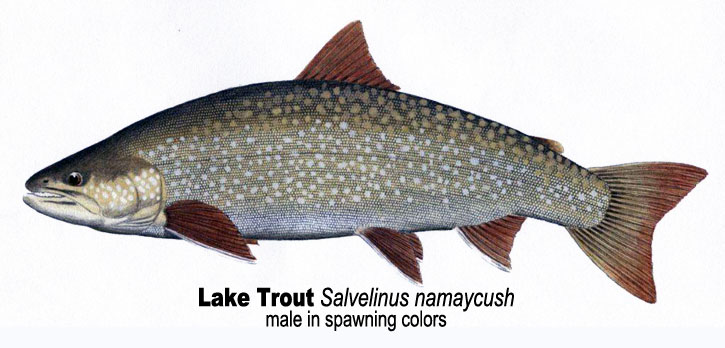 Lake Trout
Lake Trout
Salvelinus namaycush
Local Names:
Laker, Great Lakes trout, Grey trout, Togue, Longue, Namaycush,
Masamacush, Mackinaw trout & Lake char
Average Size:
18 to 26 inches
4 to 10 pounds
The Lake trout is the largest North American char, and may live as long as 40 years. Specimens weighing 50 to 100 pounds have been recorded.
Distinguishing Field Marks:
Color and color pattern are reliable distinguishing field marks for this species. (See the illustration.)
-
Lake trout have a large head, large eyes, and very large mouth, with its upper jaw extending well beyond the rear edge of the eye. The head is slightly flattened on top.
-
There are light-colored irregularly shaped spots on a darker background on the sides. The back may be marked in a light worm-like pattern, similar to that of the Brook trout.
-
There may be light spots on the dorsal, caudal, and anal fins.
-
Anal, pelvic, and pectoral fins often have white or cream colored leading edges.
-
The tail fin often has a white or cream lower edge.
-
The caudal (tail) fin is deeply forked, with a narrow caudal peduncle (wrist).
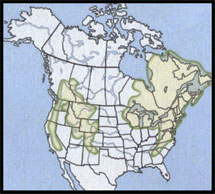
-
The anal fin has 8 to 10 major rays.
North American Range:
Map to the right shows approximate range in North America.
Biology:
Lake trout usually reach sexual maturity between ages 6 and 10. At that stage, ripe males and females gather in shallow areas of lakes (from 1 to 100 feet deep), and may occasionally ascend large tributary streams to spawn. The spawning season depends on latitude and may be as early as September in the north and as late as November in the south. Spawning takes place after dark over large gravel or rocky lake bottoms, often near large rocks. Nests are not dug, but the female clears the spawning site of silt and debris by fanning it with her tail, or rubbing it with her body or her snout. One to three males may spawn with a given female. Egg counts range from 400 to 1,200 per pound of the fish's weight, resulting in as many as 18,000 eggs being laid by large females.
On completion of spawning, the adults leave the nest areas and disperse throughout the lake or travel downstream to it.
The eggs incubate for a period of 4 to 5 months. The eggs hatch and thet fry swim freely in March or April to as late as June in northern lakes. About a month later, lake trout fry seek deep water, where they begin to actively feed and slowly grow toward adulthood.
Diet:
Young Lake trout take whatever small foods come their way, usually in the form of bottom-dwelling invertebrates, especially crustaceans. They soon graduate to a mainly fish-based diet. As large adults, Lake trout will prey on other fishes as long as 18 inches.
Fly Fishing for Lake Trout:
When the waters of large, usually deep, clear lakes and ponds are at their coolest in spring and fall, Lake trout can be found cruising in the shallows, often quite near the surface, searching for food. At this time they can be taken by casting or trolling with streamer flies. As one heads further north within Lake trout range, the fish are available to fly-fishers for an increasingly longer seasonal period. Is a fly-rodder likely to plan an expensive long distance excursion specifically to fish for Lake trout? Not likely, but those who prefer equipment and fishing techniques better suited to “getting the lure down” certainly do. That said, Lake trout are found over a broad swath of the North American Continent. They may be found in Brook trout, Landlocked salmon, Smallmouth bass, and Pike waters in the east and trout and bass waters in the west. In some waters, where they have been introduced, and are negatively impacting the native indigenous species, they’re considered a nuisance and local managers are likely to want anglers to help reduce their numbers. In contrast to that, in Lake Ontario which historically hosted vast commercially viable populations of 3 sub-species of Lake trout, to help in their restoration, fisheries managers have instituted strict season, bag, and length limits. As mentioned earlier, Lake trout do, in various places, enter rivers to spawn, making them available to fly-rodders in a moving-water situation. During the warmer months, in the more temperate part of the Lake trout’s range, these fish seasonally descend ever deeper into the water column, staying within their preferred 50 to 55 degree F temperature range. When that happens on your favorite lake, turn you attention to any species that’re less prone to deep summer sinking….
For our purposes, let's think of Lake trout as incidental spring and fall bonus catches in waters where we'd be likely to fly-fish for other species.
As always, if fishing a watershed with which you are unfamiliar, it is most important to research local outfitters, guides, and tackle shops to be prepared for specific conditions and fishing methods.
Because Lake trout can attain large sizes, if you target them, it is best to use medium weight tackle, in the 7- to 8- weight range.
Lake trout grow very slowly so, as we alluded to above, many regions where they are found have introduced “slot limits,” allowing only certain medium size fish to be killed. As always, anglers are herein strongly advised to carefully study all state and provincial regulations governing the taking of these large, interesting fish.
Significance to Humans:
Lake trout have historically been the basis of a large commercial fishery, especially in the Great Lakes. Sadly, those resources have been significantly depleted, more so in the lower lakes. Lake trout are esteemed by some as excellent table fare, but given low ranking by others. The flesh is rather fatty, oily, and may not survive long periods of freezing.
Northern Canada remains the bastion of sport fishing for large lake trout, again near the surface and close to shore of large lakes in spring and fall when the water is cool.
Status:
Depleted in much of its native range, but maintaining in many watersheds, the species is under review in many areas and the subject of restoration programs, notably in the lower Great Lakes. Because it lives at great depths, the lake trout remains something of an enigma.


